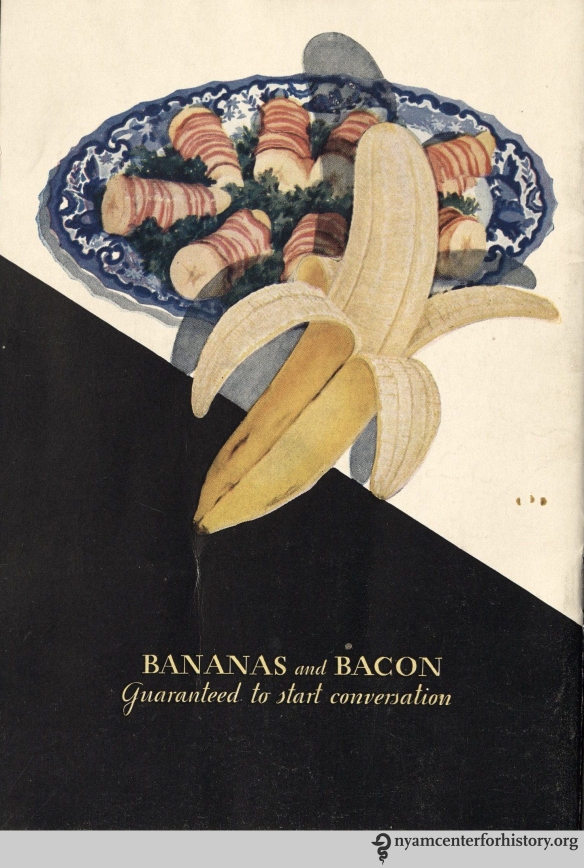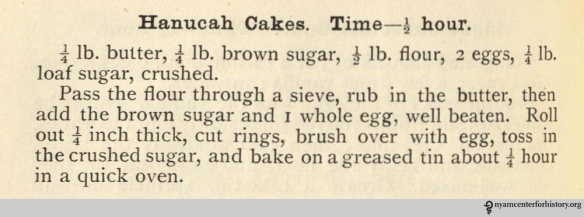By Anne Garner, Curator, Center for the History of Medicine and Public Health
This is one of several posts leading up to our day-long Eating Through Time Festival on October 17, 2015, a celebration of food, cookery, and health. View the full program and register for the Festival.
Among the many attractions at the Philadelphia Centennial Exposition of 1876 were the bananas. Wrapped in foil and sold for a dime each, they were a novelty for many Americans who had never seen them before.1
In the decades that followed the Exposition, the United Fruit Company (now Chiquita) was responsible for introducing many more Americans to the fruit, promoting the banana in their literature, and distributing them throughout the country.
The story of the UFC begins in 1871, when cattle rancher Minor C. Keith first planted bananas alongside the tracks of the national railroad in Costa Rica. By the 1880s, Keith was the dominant banana trader in Central America. In the same decade, Lorenzo Dow Baker founded Boston Fruit, the first to import bananas in the U.S. Keith’s enterprise merged with Boston Fruit in 1899 to create the United Fruit Company.
During the next decade, United Fruit Company’s Great White Fleet, painted white to reflect the intense sun, carried bananas from Central America to the U.S. An increasing number of refrigerated train cars pushed bananas further inland, to places they had never gone before.
Beginning in the early 20th century, the United Fruit Company promoted the banana in a series of pamphlets and ads, taking it from a little-known novelty to a household staple. At the heart of their campaign was an endorsement of the fruit’s healthy properties. During the 1920s, the United Fruit Company hired doctors to extol the nutritional virtues of the fruit. In 1939, they offered free textbooks—decidedly pro-banana—to schoolchildren.2
The Academy Library has a number of historical pamphlets produced by the United Fruit Company and its distribution arm, The Fruit Dispatch Company. Here, we offer a selection of images from our collection.

“The Food Value of the Banana,” 1917, page 35.
In 1917 the United Fruit Company published “The Food Value of the Banana,” a collection of 15 opinion pieces touting the virtues of the banana as a nutritious snack. “Points about Bananas” concluded the volume.
The United Fruit Company’s test kitchens reported in 1924 that bananas with corn flakes and milk made the best breakfast for families.3 The company’s subsequent publications emphasized that bananas were powerfully healthy, especially for the very young.

Cover of “The Food Value of the Banana,” 1928.
The cover of the fourth edition of “The Food Value of the Banana,” published in 1928, features a rosy-cheeked and radiant little boy, banana in hand.

“The Food Value of the Banana,” 1928, back cover.
The back cover of the same 1928 pamphlet explains the ideal time to consume a banana, and how it can be eaten in each phase of ripeness. Most bananas cycle from green to yellow to yellow with brown spots in seven days.4

Ad in Woman’s Medical Journal, vol. 52 no. 6, June 1945.
In the 1920s, UFC hired doctors to publicly recommend that babies should consume mashed bananas. Researcher Sidney Haas found that children diagnosed with celiac disease who had been given a diet of milk and bananas dramatically improved (of course bananas are gluten free, which may have had something to do with it).5 Here, an ad from the Women’s Medical Journal from 1945 (v.52, no.6).

Cover of “The New Banana,” 1931.

From “The New Banana,” 1931. Click to enlarge.
The Fruit Dispatch Company’s 1931 newspaper-format pamphlet, “The New Banana,” tells stories in which the banana’s hero status is high. In one, a Norwegian hikes from Oslo to Christianssand. Nourished by the banana, “his strength increased from day-to-day!” In another, the banana sustains two transatlantic pilots (and fits compactly into the cockpit).

“The New Banana,” 1931, back cover.
The Scientific News section of “The New Banana” reminds parents of the considerable nutrients in the banana: vitamins A, B, and C, calcium, magnesium, and iron. It’s also “non-fattening” though not especially so when paired with bacon, as on the back cover.

Cover of “Serve Bananas in ‘Latest Style,’” 1940.
The Fruit Dispatch Company published “Serve Bananas in ‘Latest Style’” in 1940 to introduce new banana recipes to American households. Recipes included “ham banana rolls with cheese sauce” and “banana fritters” as well as a “banana sweet potato casserole.” We’re charmed by the lady banana with the Elizabethan collar waving her napkin. She predates the United Fruit Company’s Chiquita Banana by four years.

Cover of “Banana Salad Bazaar,”1940

“Banana Salad Bazaar,”1940, pages 2 and 3. Click to enlarge.
“Banana Salad Bazaar,” produced by the United Fruit Company’s Home Economics Department in 1940, is introduced by a sign-waving banana-man announcing “This Way to the Salad Bazaar.” Salad makers are encouraged to use fully ripe bananas (yellow peel flecked with brown). Recipes include banana gelatin salad and banana sardine boats.

From “Nutritive and Therapeutic Values of the Banana,” 1941.
1941 was a busy year for the UFC’s presses. Here, a chart from the second addendum to “Nutritive and Therapeutic Values of the Banana,” an annotated bibliography of recent research devoted to the fruit. The forward tells us that the banana pictured is a Gros Michel, or “Big Mike” banana, imported to the U.S. since the late 1890s. The “Big Mike” was larger, with a sturdier peel, and anecdotally more flavorful. By 1960 “Big Mikes” had been almost entirely eradicated by Panama disease. On American tables it was replaced by the Cavendish.6

From “Bananas…How to Serve Them,” 1941.
This inset from “Bananas…How to Serve Them” (1941) illustrates the health benefits of bananas at every age. We learn that the Dionne quintuplets (b. 1934), the earliest quints to survive their infancy, ate bananas. Bananas are a “training table favorite” for athletes, and they appeal to the elderly as well because they are easy to chew and digest.

From “Bananas…How to Serve Them,” 1941.
On the left, a sweet banana artist paints bananas at three stages of ripeness and explains how to prepare bananas for meals at each phase. On the right, encouragement for the housewife, with a promise of new banana recipes on the pages that followed. A monocled banana with a cane and top-hat below rips off Mr. Peanut, well-known to Americans since the early 1930s.

From “Chiquita Banana’s Cookbook,” 1960, page 2.
Inspired by Carmen Miranda’s character in Busby Berkeley’s The Gang’s All Here, United Fruit Company introduced Chiquita Banana in 1944 (Miranda herself was frequently called, “chiquita” in her films). Dik Brown, creator of Hagar the Horrible, drew the first Chiquita; advertising execs composed her famous song.7 Here, a 1960 iteration of Chiquita graces “Chiquita Banana’s Cookbook.”

Detail in “Chiquita Banana’s Cookbook,” 1960, page 3.
In “Chiquita Banana’s Cookbook,” Chiquita offers ideas for decorating with bananas. Here, “fruit in a scoop” and a banana bouquet, in a pressed-glass stand.

From “Chiquita Banana’s Cookbook,” 1960, page 12.
Under consideration by Betty Draper and the Mad Men set: a triptych of bananas in “Chiquita Banana’s Cookbook,” prepared with three different garnishes: a currant jelly, a curry sauce, and mint jelly.

“Chiquita Banana’s Cookbook,” 1960, pages 4-5. Click to enlarge.

“Chiquita Banana’s Cookbook,” 1960, pages 6-7. Click to enlarge.
“Chiquita Banana’s Cookbook” offers an adorable banana bunny and a banana skillet breakfast, as well as new recipes for shakes. “Drink a banana and feel better for it,” says Chiquita, and we believe her because she’s wearing that amazing hat.
References
1. Hooker, Richard J. Food and Drink in America. Indianapolis: Bobbs-Merrill, 1981.
2. Koeppel, Dan. Banana. The Fate of the Fruit That Changed the World. New York: Hudson Press, 2008.
3. Koeppel, 75.
4. Koeppel, xv.
5. Levinovitz, Alan. “The First Superfood.” Accessed September 1, 2015 at http://www.slate.com/articles/health_and_science/science/2015/04/the_first_superfood_doctors_believed_bananas_could_cure_celiac_disease.html
6. Koeppel, Dan. Banana. The Fate of the Fruit That Changed the World. New York: Hudson Street, 2008. xiv.
7. Koeppel, 117; 253.














![From: McDermott, S. Metaphysics of Raw Foods. Kansas City, Mo. : Burton Pub. Co.; [c1919]. Click to enlarge.](https://nyamcenterforhistory.files.wordpress.com/2015/12/mcdermott_metaphysicsofrawfood_1919_table_watermark.jpg?w=584&h=486)






































![Cover of Annette Lucas’ La cuisinière, cordon bleu de la famille ...Paris: E. Guérin, [1905].](https://nyamcenterforhistory.files.wordpress.com/2015/09/cuisinierecordonbleu_1905_watermark.jpg?w=258&h=413)

![Cover of Emile Dumont’s Le parfait patissier : recettes pour la ville et la campagne : entremets sucrés, patisserie, confiserie, glaces, liqueurs, vins en futs et en bouteilles, cidre et poiré. Paris: Degorce-Cadot, [188?].](https://nyamcenterforhistory.files.wordpress.com/2015/09/dumont_parfaitpatissier_187_cover_watermark.jpg?w=584&h=939)






